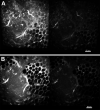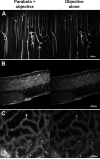Compact non-contact total emission detection for in vivo multiphoton excitation microscopy
- PMID: 24251437
- PMCID: PMC4132828
- DOI: 10.1111/jmi.12099
Compact non-contact total emission detection for in vivo multiphoton excitation microscopy
Abstract
We describe a compact, non-contact design for a total emission detection (c-TED) system for intra-vital multiphoton imaging. To conform to a standard upright two-photon microscope design, this system uses a parabolic mirror surrounding a standard microscope objective in concert with an optical path that does not interfere with normal microscope operation. The non-contact design of this device allows for maximal light collection without disrupting the physiology of the specimen being examined. Tests were conducted on exposed tissues in live animals to examine the emission collection enhancement of the c-TED device compared to heavily optimized objective-based emission collection. The best light collection enhancement was seen from murine fat (5×-2× gains as a function of depth), whereas murine skeletal muscle and rat kidney showed gains of over two and just under twofold near the surface, respectively. Gains decreased with imaging depth (particularly in the kidney). Zebrafish imaging on a reflective substrate showed close to a twofold gain throughout the entire volume of an intact embryo (approximately 150 μm deep). Direct measurement of bleaching rates confirmed that the lower laser powers, enabled by greater light collection efficiency, yielded reduced photobleaching in vivo. The potential benefits of increased light collection in terms of speed of imaging and reduced photo-damage, as well as the applicability of this device to other multiphoton imaging methods is discussed.
Keywords: Imaging; light collection; two-photon microscopy.
Published 2013. This article is a U.S. Government work and is in the public domain in the USA.
Figures






Similar articles
-
Optimizing multiphoton fluorescence microscopy light collection from living tissue by noncontact total emission detection (epiTED).J Microsc. 2011 Feb;241(2):153-61. doi: 10.1111/j.1365-2818.2010.03411.x. Epub 2010 Jun 21. J Microsc. 2011. PMID: 21118209 Free PMC article.
-
All-near-infrared multiphoton microscopy interrogates intact tissues at deeper imaging depths than conventional single- and two-photon near-infrared excitation microscopes.J Biomed Opt. 2013 Oct;18(10):106012. doi: 10.1117/1.JBO.18.10.106012. J Biomed Opt. 2013. PMID: 24150231 Free PMC article.
-
Fluorescence microscopy gets faster and clearer: roles of photochemistry and selective illumination.Yale J Biol Med. 2014 Mar 5;87(1):21-32. eCollection 2014 Mar. Yale J Biol Med. 2014. PMID: 24600334 Free PMC article.
-
Advantages and risks of multiphoton microscopy in physiology.Exp Physiol. 2002 Nov;87(6):709-14. doi: 10.1113/eph8702464. Exp Physiol. 2002. PMID: 12530403 Review.
-
Two-photon microscopy of cells and tissue.Circ Res. 2004 Dec 10;95(12):1154-66. doi: 10.1161/01.RES.0000150593.30324.42. Circ Res. 2004. PMID: 15591237 Review.
Cited by
-
A pragmatic guide to multiphoton microscope design.Adv Opt Photonics. 2015 Jun 30;7(2):276-378. doi: 10.1364/AOP.7.000276. Adv Opt Photonics. 2015. PMID: 27182429 Free PMC article.
-
Long-working-distance high-collection-efficiency three-photon microscopy for in vivo long-term imaging of zebrafish and organoids.iScience. 2024 Jul 19;27(8):110554. doi: 10.1016/j.isci.2024.110554. eCollection 2024 Aug 16. iScience. 2024. PMID: 39184441 Free PMC article.
-
Modeling cardiac complexity: Advancements in myocardial models and analytical techniques for physiological investigation and therapeutic development in vitro.APL Bioeng. 2019 Feb 5;3(1):011501. doi: 10.1063/1.5055873. eCollection 2019 Mar. APL Bioeng. 2019. PMID: 31069331 Free PMC article. Review.
-
Motion compensation for in vivo subcellular optical microscopy.J Microsc. 2014 Apr;254(1):9-12. doi: 10.1111/jmi.12116. J Microsc. 2014. PMID: 24673143 Free PMC article. Review.
-
Imaging in turbid media: a transmission detector gives 2-3 order of magnitude enhanced sensitivity compared to epi-detection schemes.Biomed Opt Express. 2016 Aug 30;7(9):3747-3755. doi: 10.1364/BOE.7.003747. eCollection 2016 Sep 1. Biomed Opt Express. 2016. PMID: 27699135 Free PMC article.
References
-
- Combs CA, Smirnov A, Chess D, McGavern DB, Schroeder JL, Riley J, Kang SS, Lugar-Hammer M, Gandjbakhche A, Knutson JR, Balaban RS. Optimizing multiphoton fluorescence microscopy light collection from living tissue by noncontact total emission detection (epiTED). J Microsc. 2011;241:153–161. - PMC - PubMed
-
- Combs CA, Smirnov AV, Riley JD, Gandjbakhche AH, Knutson JR, Balaban RS. Optimization of multiphoton excitation microscopy by total emission detection using a parabolic light reflector. J Microsc. 2007;228:330–337. - PubMed
Publication types
MeSH terms
Substances
Grants and funding
LinkOut - more resources
Full Text Sources
Other Literature Sources
Molecular Biology Databases

